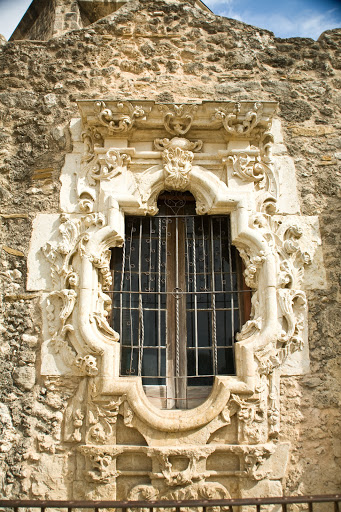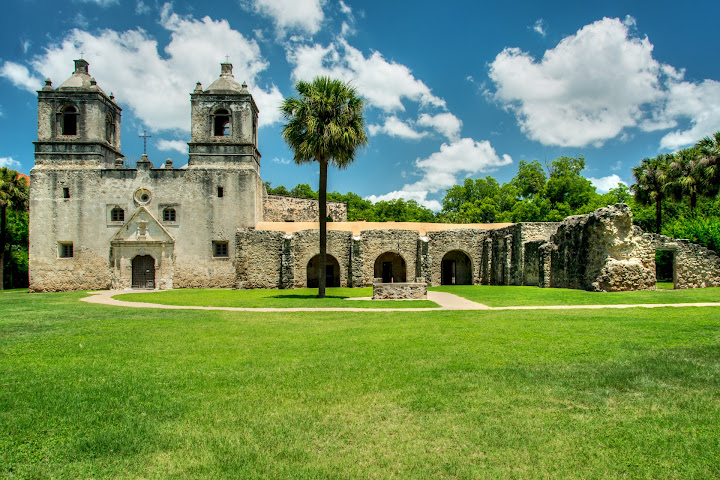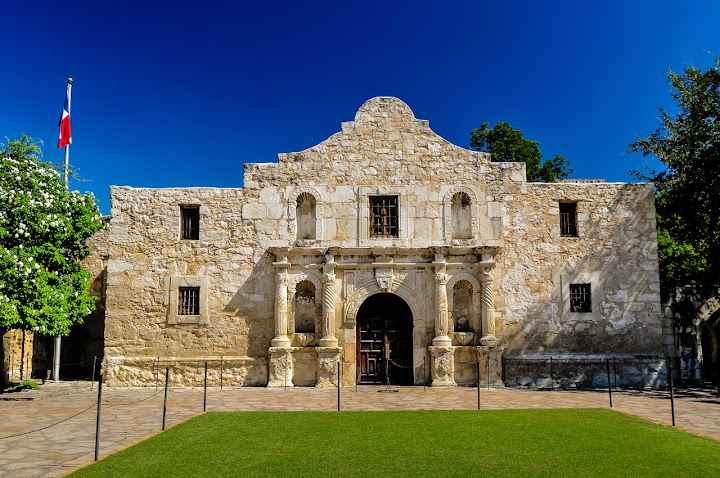San Antonio is a city that never sleeps. Hordes of tourists, cameras at the ready, vie for space on noisy, downtown sidewalks near the busy River Walk. Visitors snap photos in front of Ripley’s Believe It or Not, Louis Tussaud’s Waxworks, or along a string of souvenir shops.
Across the street at the Alamo Plaza, another throng mills around the San Antonio de Valero mission entrance. More intent on proving they saw a historic site, these tourists shoot selfies in front of “The Alamo,” the best known Texas landmark.
The Spanish plaza area’s circus-like atmosphere has been the city’s nerve center for decades. Amid double-decker tour buses and old fashioned trolleys, tourists flock here to drink, dine, and be entertained along the adjacent River Walk.
But visitors searching for the city’s cultural roots now have the support of the United Nations Educational, Scientific and Cultural Organization. That’s because on July 5, 2015, UNESCO conferred the prestigious designation of “World Heritage Site” on San Antonio’s five Spanish colonial missions.
Situated a few miles south of the city center, the 18th century missions are the first and only designated World Heritage Sites in Texas. The United States has fewer than 25 of these cultural sites. They include Independence Hall (1979), the Statue of Liberty (1984), and Monumental Earthworks at Poverty Point (2014).
Now the historic missions are in the same worldwide league as the Alhambra Palace in Spain (1983), Stonehenge in Britain (1986), and Machu Picchu in Peru (1983), all of which UNESCO chose for their global cultural, social and educational significance.
The Spanish founded Mission San Juan Capistrano in 1716, Mission San Antonio de Valero in 1718, Mission San Jose y San Miguel de Aguayo in 1720, Mission San Francisco de la Espada in 1731 and Mission Nuestra Señora de la Purísima Concepción Acuña in 1731.
The mission system established under the Spanish crown and administered through its Catholic missionary priests (Franciscan friars) was more than a mission. Missions were vibrant towns with a church whose bells tolled as a means of guiding its residents. In short, missions were church-focused communities.
Missions were the hub of religious and secular activity for indigenous people more than 100 years before Texas Independence in 1836. The missions, nearly 300 years old, played a major role in the introduction of ranching, farming, and many other skills in frontier Texas.
For example, the friars integrated Texas-born Mexicans called “Tejanos,” of Indian and Spanish ancestry. The Tejanos were the first “vaqueros” or cowboys who guided cattle and sheep as far as Louisiana and Mexico, according to the National Park Service, which preserves unimpaired natural and cultural resources. The NPS also notes that the Texas Longhorn evolved from three Spanish breeds.
But the saga of the chain of missions-the essence of the history of Texas and San Antonio- has never been commercially promoted. In fact, many Texans only know “The Alamo,” a moniker for Mission San Antonio de Valero and the most centrally located of the five designated missions.
Yet the true history of San Antonio and Texas is easily accessed through the 8-mile Mission Reach project completed in 2013. The Mission Reach is an extension of the River Walk connecting the four missions via South Town, an area bursting with activity from hotels, restaurants, and boutiques.
The River Walk extension enables visitors to conveniently plan their mission itinerary. From “The Alamo,” travel directly south to begin your extraordinary sojourn through Mission Concepcion, Mission San Jose, and on to Mission San Juan and finally to Mission Espada.
Additionally, visitors can walk, hike, bike, and even picnic on the greenbelt that runs south along the newly extended River Walk. Sport enthusiasts can enjoy canoeing, kayaking, and nature watching along the Mission Reach.
The inexpensive city trolleys also offer tourists quick transportation to the missions. Private tour buses as well as double-decker buses are now part of San Antonio’s daily landscape.
For the history buff, a stroll through each of the four missions is an inspiring journey.
The mission system was a mechanism used by Spain to transfer its culture and Catholic religion to inhabitants of their vast domain. This domain included but was not limited to Arizona, California, Colorado, Florida, New Mexico, and of course, Texas.
Missionaries schooled the natives in the Spanish language, so they could become Spanish citizens. They sought to convert them to the Catholic faith. But beyond religion, friars taught the Indians skills such as farming, ranching, weaving, wheat grinding, brick and tile-making, and many other skills.
Mission San Juan Capistrano
Mission San Juan Capistrano has a church, convent, granary, living quarters, and an “acequía” or irrigation system dating to Moorish Spain. It once housed some 41 families and as many as 160 people.

The acequía helped produce an abundance of crops and still functions today. In fact, a member of San Antonio’s Professional Tour Guide Association demonstrated how the acequía actually worked back in the day.

Mission San Jose y San Miguel de Aguayo
Mission San Jose y San Miguel de Aguayo, dubbed the “queen of the missions,” is the largest of the five missions. It was moved from East Texas to its current San Antonio River location between 1721 and 1724. Governor of Texas and Coahuila, Marques de Aguayo, gave permission for its construction in 1720.


One of the highlights of Mission San Jose is “La Ventana de Rosa” or “Rose Window.” Legend has it that the sculptor, Juan Pedro Huizar, named the intricately hand- carved limestone window for his beloved Rosa.

Another outstanding feature is the Spanish colonial wheat mill with a horizontal wheel. During a recent visit, the scent of freshly mill-ground wheat filled the air. Strolling through the hallowed grounds conjures images of Coahuiltecan Indians served by this mission.
Mission Concepcion
Mission Concepcion, with its intricate ornate façade, is a compelling example of Spain’s Moorish heritage. Once in the church, visitors notice a dramatic emphasis on geometric and astronomical design. They are drawn to a round window high above the choir loft, a great example of Moorish architecture.

Art and architectural students should visit the missions before studying abroad. The cruciform structure, with twin towers, barrel-vaulted roof, and dome ceiling are outstanding.
Frescos represent religious imagery and form part of the architectural design of Mission Concepcion and all the missions.

Mission Espada
Mission Espada, with its rustic three-bell facade, represents the most complete mission complex of all the missions. The walled compound includes a church, granary and more. This mission is situated on original farmland and has an aqueduct, a dam and an Acequía that’s been functioning since 1745

Mission San Antonio de Valero
Mission San Antonio de Valero has retained its authentic mission façade despite its noisy commercial surroundings. Built in 1718, the mission served several purposes, which included converting the native population to Catholicism.
This mission’s population rose to more than 300 by 1756. Records show that nearly 1,000 indigenous converts were buried on the mission grounds. By 1830, this famous battle site had a population of nearly 2,500 inhabitants. Most of the settlers were descendants of people who were drawn to the Spanish mission system.

The Mission Trail
Today, the mission trail is administered by the San Antonio Missions National Historic Park organization while the NPS maintains mission facilities. The visitor center is in mission San Jose. It offers visitors detailed maps to help guide them through the four-mission chain.
UNESCO’s designation will attract tourists from all over the world to San Antonio’s ancient hallowed grounds. And that’s a plus for the city, business and most of all, anyone who wants a less commercial vacation experience.
For more information on visiting the missions, contact the San Antonio Convention & Visitor’s Bureau at www.visitsanantonio.com. For professional tour guides, go to www.sanantoniotourguides.org. For more information on the world heritage designation, visit: www.unesco.org.
Rosie Carbo is the Lifestyles Editor for Wandering Educators, and is a former newspaper reporter whose work has appeared in newspapers and magazines nationwide. Some of those publications include People magazine, The Dallas Morning News, The Houston Chronicle and San Antonio Express-News. Some of her features were redistributed by The Associated Press early in her career as an award-winning Texas journalist.
All photos courtesy and copyright Bob Howen for the SA Convention & Visitor's Bureau, used with permission
